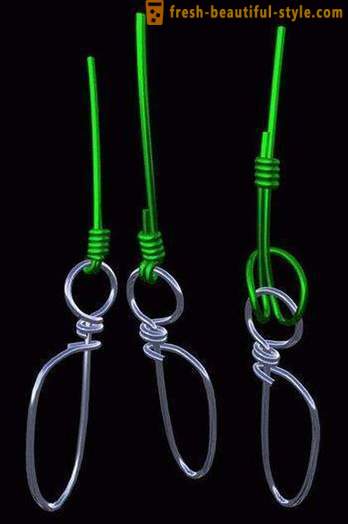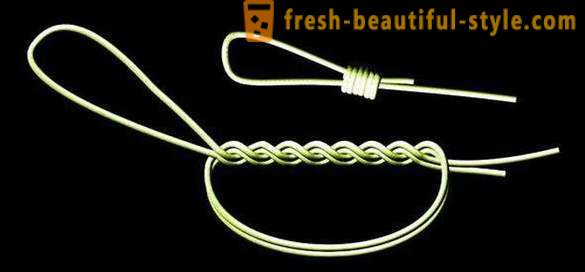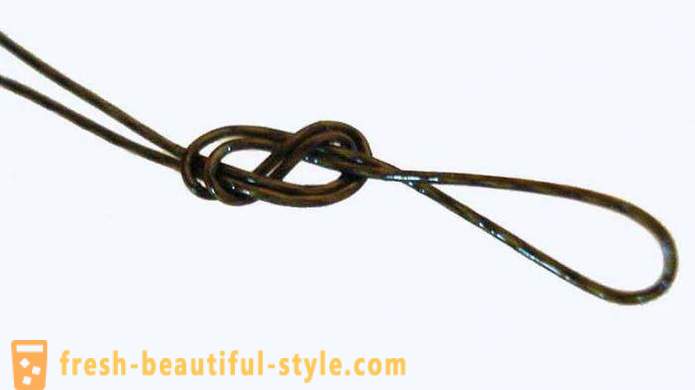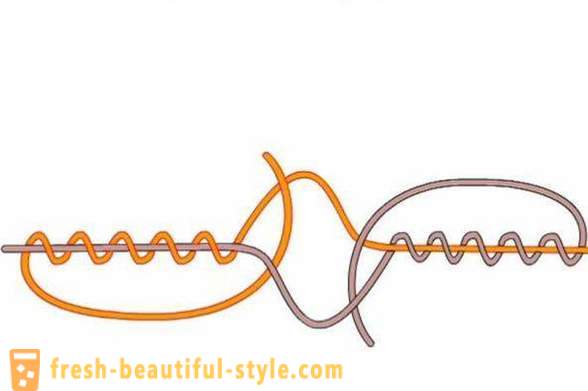Fisherman's knot. Knitting fishing knots. Fishing knots for leashes
This fisherman must not only know how and where to catch a particular fish, but also have certain skills to mount and configure their fishing devices. One such abilities is knitting fishing knots, without which it is a part tackle. They are widely used in fly fishing, float and bottom fishing.
What are fishing sites?
Fishing loops and knots are used during installation to tackle:
- tying hooks;
- attachment swivels;
- baits fixing;
- attaching fishing line to the reel spool;
- limit the movement of the float;
- binding leashes;
- two binding grove (including various modifications and sections..);
- tying fishing line to string, gum, etc.
In addition, some reliable fishing sites can be used for attachment to the load gear. They can also tie the boat anchor and moor boats themselves.
The strength of the fishing gear units depends not only on the reliability of used fishing line or string, but also on the accuracy of their knitting. A significant role also plays an understanding of where they can be used.
Let's start with all
Knitting fishing knots - is a science that requires not only knowledge of the theory, but also the practices. To begin, it is desirable to work out with a piece of soft cord, and then move on to the line. In this article we will try to create you an understanding of what the fishing sites. Photos of the main varieties are as follows.

There are hundreds of types of fishing knots. To describe them all is impossible. Therefore, we will look at how to knit fishing knots, which are often used as detents as well as for tying leashes, hook and some bait. But first, let's understand the basic terms that are used to describe the process of knitting. Only two of them:
- bitter end - the end of the string or fishing line, which is not involved in the process of tying the knot (fixed);
- running (operating) end - free (unattached) end of which is directly and creates fisherman's knot.
The locking unit "clinch"
This type of node is designed to limit the stroke of the sliding of the float used for fishing from the bottom. Usually it is not used knitting fishing line, as usual, or woolen thread of bright color. Knitting process is quite simple: we take the thread segment (15-20 cm), bending it in half and attached to a fishing line, so that it is inside the half-loop thread. A hot end of the fishing line winding and root end 6-8 times and then passes it through a loop formed. Further damp node water and tighten. Cheroots, leaving 1, 5-2 cm. This is to ensure that the unit is easily passed through the crossing of the ring.
Stopper "Duncan"
"Duncan" - a more reliable and sophisticated analog "clinch", used for the same purposes. This fisherman's knot can be knit from monofilament fishing line. He almost does not stretch and tight.
The length of the monofilament (15-20 cm) is folded into halves, perehlestyvaya ends and attached to the main line so that the loop is formed from the top. The working end is brought under the line, entwine them, and it was passed into the loop. Next, do 4-5 of turns damp and tighten knot. Do not forget to cut off the ends, leaving at 1, 5-2 cm.
"Blood" node
Fisherman's knot with a scary name "blood" is one of the oldest. It is known that it was used even sailors of Columbus times. Its name he received because of the fact that very often the end of the whip for corporal punishment sprang up precisely this node. "Blood" is highly versatile and has a strength of 70-75%.
Fishing units of this type used to bind the scaffold, regardless of its type and cross-section, as well as for tying leashes.
Fit "bloody" as follows. Take two pieces of fishing line, we put them together in parallel. The working end of one of the segments wrap around another 5-6 times, then wrap it and threaded into the opening between the fishing line. We perform the similar action and a working end of another segment.
Further damp node water and tighten. Cheroots.

Node "bloody reverse"
Units of this type are best suited for the binding of monofilament fishing line thickness up to 0, 4 mm. Braids for them practically do not use. Fishing knots for leashes of this kind are very strong (90-95%), are compact and allow the fishing line to connect different diameters.
The process of knitting the next. Leski add up in parallel. The working end of one of them entwine another, making 5-8 turns. Taking his left hand last round, are making the same number of turns in the opposite direction. Now skip the end of the opening between the line.
Similar action is performed with a second working end. Further damp our design and stretch the fishing line in different directions, the resulting tightening knot. Do not forget to remove the extra twine. Fishing knots for leashes should not have protruding ends, so they should be carefully cut.
Node "fishing"
This node is not particularly strength (60-65%) and is used exclusively to bind braided fishing line. It's pretty simple to perform and is perfect for novice anglers.
Two pieces of fishing line are parallel to each other. The working end of one of them twine around the other to form a loop. Further, the holding fingers the loop, the end of the fishing line is wound for two and passes it to the first loop. We perform the same operation with the second scaffold. We should now have two of the same node. Now, cheroots, wetting the entire structure and drag over the two fishing lines in opposite directions. The nodes at the same time be displaced to each other and unite into one.
Node "triple"
"Triple" is increasingly used for linking monofilament fishing line of the same diameter. It is sufficiently strong (90%), and is simple in knitting.
Fold two fishing line that you want to link end to end. We press their fingers at a distance of 15 cm from the edge. From both ends making a simple knot, making sure that the edges are not dispersed and did not speak. Several times threaded ends to form a loop, wrapping it. Now moistened with water or saliva assembly and tighten it. Cheroots, leaving 1-1, 5 mm.
Node "centaur"
"Centaur" is also easy to fit and has high versatility. This is the most reliable fishing nodes having the strength of 90-95%. They are used for attachment leashes and binding scaffold of any type and diameter. This assembly is extremely compact, due to what is used in a wide variety of installation.
It fits "centaur" follows. Two fishing lines are arranged in parallel. The working end of one of them loosely entwine the second 5-6 times, then it is we start from the beginning of the "spiral", extending therethrough. Now tighten the resulting knot. The same procedure is carried out with the working end of the second scaffold. Further, as in the case of the "Fisherman", stretch the fishing line in hand. When a node is tightened, it is possible to cut off the ends.
Node "vine"
"Vine" is most often used to bind the broken fishing line. This fishing site is not difficult in the knitting, but quite durable (75-80%), though inferior to "Centauri". Not recommended for platting.
Fit he is. Two fishing line add up in parallel, one end of the working recurve and entwine them both strands. Further, it is passed in a loop and do five turns around one of its sides and a second fishing line. Delayed. The same is done with the second working end. Stretch the fishing line in hand, cut off the ends. These fishing sites suitable for binding filaments of different diameters.

Node "nail"
"Nail" is used for the gear, working with a full load (spinning, carp and leschovye feeders, etc.). Suitable for both monofilament and for platting. The only requirement for its installation - presence at hand a thin tube, rod-like ink from a pen.
Fishing line disposed in parallel. Between them, put a tube. One of the working ends make 10 turns around both woods and the tube in the opposite direction from it. It is passed into the tube and remove it.
We perform the same operation with the second end. Tighten the knot, stretching fishing line. Cheroots.
But how to tie a fishing knot "nail", if the hand is not tube? In this case, you can use the needle, threading the line in her ear.
Node "water"
This type of node is universal. It can be used to bind various line and bind leashes. Knitted quickly, but does not have high strength (60-70%).
Two fishing line add up in parallel, we catch them with your fingers, and pull a little cranking clockwise, thus forming a loop.
Ends that are left to adhere to, and those on the right, passed through a loop of 3-4.
Moistened knot and tighten it. Do not forget to cut off the ends.
"weaving" the
"Weaving" node is most often used to bind two completely different diameters woods. With it, you can also quickly attach the line to the nylon cord or fishing gum. "Weaving" node has a strength of 90-95%.
The working end of the fishing line or a thick cord folded back, and the resulting loop thread threaded with a smaller cross section. Stretch it for a loop and entwine the outside, making 4-5 turns. Skipping the working end between the first line and cord coil. Tighten our design, the cut end is not too short.
nodes for connection of line type "loop to loop"
Compound loop in a loop more reliable than a simple binding. This method is perfect for attaching a leash to the main line. But also need to tie knots for him.
Take the main line and, at a distance of 4-5 cm from the edge, bending it in half and folded in half. Making a simple knot, leaving a loop 2-2, 5 cm. Tighten it after moistening. We do the same thing with the other fishing line.
Now that we have two loops of fishing line to the ends, threading one loop to another, and the end of one of them (which is thinner) is passed through the first of them. We tighten our unit by pulling the main line and the lead in different directions.
We covered the basic fishing knots, which are used for locking the float, binding and tying leashes woods. But there are other types, intended for other purposes. It may be tying the hook, swivel or locking bait. There are also fishing knots used. How to tie them properly, consider the following.

hook assembly with the vane to pass the outer scaffold
This node is only applicable to monofilaments.
Stepping back from the end of the fishing line of 12-15 cm, hold this place his left hand and attached to the hook blade. Next, form a loop where the forearm passes into the sting. The working end of the fishing line entwine and forearm 8-10 times, then skip it in a loop. Tighten the knot, throwing the ends to the sides.
Cut the end of the fishing line, leaving 1, 5-2 mm.
hook assembly "Trombone loop"
"Trombone loop" - a fishing hook assembly with a shovel, used for both monofilament and for platting.
Of fishing line do half loop with the end of 12-15 cm. To top it putting a hook so that the root end is parallel to its tsevyu, and presses his fingers. The working end of the forearm and wrapped with twine several times. It hooks hook to the other hand and do another 3-4 turns. End of threaded in a loop, moisten and tighten knot. Cut off the excess twine.
fisherman's knot "eight" for tying the hook with eyelet
This knot is the most reliable for lashing hook. Whatever happens, he will not fail. It fits it as follows.
End of line is passed through the ear, wrap it several times around the forearm and then threading it into a ring hook. Next, do one turn around the line and return to the loop, formed at the bottom. Wetting and tighten knot. The cut end.
node "Palomar"
"Palomar" - reliable and easy assembly. Used for tying large hooks with eyelet, swivels and baits such as jig. It can be used for plaiting.
Lesko appears to be doubled so that a loop length of 10-12 cm, is passed into the top of your ear and tied in a simple knot. Skip the hook through the top of the first loop. Moistened knot and tighten it properly. Surplus cut the fishing line, leaving about 2 mm.
Advanced "Clinch" node hook with eyelet
Simple and rugged unit for monofilament fishing line. knot strength was 98%.
Threaded end of the fishing line through the eye and stretch for 8-10 cm. Swathe of them the main line 5-8 times and passed through a loop around the ear. Return the end of the back, threading it through the loop. Wetting and tighten knot. Cut end, leaving 1-1, 5 mm.

Durable "clinch" with an ear hook for
Very durable knot used for tying hooks and swivels.
Fishing line is folded into two so as to obtain a loop length of 12-15 cm. It is threaded into a ring hook and folded into halves. A hot end of the fishing line is wound every 5-7 times and miss it in the top of our loop. Wetting and tighten knot.
Node "Homer" to the hook eye with
"Homer" - the universal unit with an ear hook that is suitable for any type of fishing line. Its distinguishing feature is the strength of which depends on the number of turns made. Running end is threaded through the eye and extends to 10-12 cm. Form a loop by wrapping them the main line, and tying a simple knot, without tightening it. Making 5-7 turns, return it to an end. Wetting and tighten our site. Cut the edge of the fishing line, leaving 1-1, 5 mm.
Node "grinner" hook with eyelet
"Grinner" is also one of the strongest knots for hooks. It is recommended for both monofilament and for platting.
Skip the line through the eye, extending it to 10-15 cm. The bending it in half and stifle the top of your fingers. A hot end of the fishing line is wound, both by 5-7 times, and it is passed to the top of the loop. Tighten the knot, do not forget to moisten it. The cut end.
Voblerny node "tight loop"
"Thick Loop" is used for tying lures, spinners, jig-heads and other baits, in Vol. H. And fly fishing as well as for fixing the metal leash.
Stepping back from the end of Leckie 12-15 cm, making a simple knot, without tightening it. Skip to end fastening bait ring, and further through the previously formed bundle. We tighten our attachment. After that, the same end doing another simple knot. Tighten and cut off the end of the fishing line.

Voblerny node "deaf" loop
As in the previous case, we make a simple knot at a distance of 12-15 cm from the edge of the scaffold, without tightening it. The end of the fastener is inserted through the wobbler ring and return it back, passed through our easy assembly and display over the fishing line. Having made one turn, again we start it in a loop and is held in a gap between two Lesko below. Wetting unit and tighten. Cut the end, leaving the 1-1, 5 mm.
"Rapala" Voblerny the
This corporate unit - the invention of the specialists of the Finnish company "Rapala", specializing in the production of artificial baits for fish. It differs in that it is bound to help lure is always in the correct position without pulling or twisting. As in previous cases, forming a simple knot at a distance of 12-15 cm from the edge of the fishing line. Running end is passed through the fixing ring wobbler and conduct it through our site. Swathes of their main line of not less than 5 times and return it back. Tighten the knot, do not forget to moisten it. The cut end.
assembly for lateral leash loop time
Fishing is often necessary to tie leashes to the main line. This can be done only by forming a loop on it. Temporary loop does not worsen gear characteristics, and it can be easily untie when necessary.
Take the main line and double wrapped with her index finger of his left hand. Remove the coils and clamping them at the base, so they do not have blossomed. Running end of the fishing line to form a simple loop and pass it through our coils. Holding in one hand the working end and the other - the main line, tighten the resulting knot. The loop will then be reduced.

Now, to snap the leash, it is necessary that he had at the end of any site, such as "eight". Sell it in our loop, we tighten it and get the mobile structure. According uselessness loop can be loosened, remove from her leash and stretch the main line with a knot in hand. The loop will disappear and the line was straightened.
Node for lateral leash constant loop
If the tackle involves the constant use of the side of the leash, it is better to make a fixed loop. To do this in the right place at the main line fold it in half to form a loop of 10-12 cm. Its base presses the fingers of his left hand, and toss in the top side of the thumb. Now the base loops intercept his right hand, and vershinku plants to the index finger of his right hand. Repeat this technique 4-5. By doing this, you need the top of the loop thread the fishing line between the turns of the loop. Stretching the main line to the side, delaying the node previously moistening it.













































